Q&A – Ask Neil: June 9, 2022

(Please read these instructions carefully.)
I hope you’re enjoying this new Q&A format. We’re still making minor adjustments, but it’s getting better.
• Click here to post your question.
• After you submit your question, a new window will pop up giving you the address to which you can e-mail a photo to accompany your question. Clear, medium-resolution photos (not thumbnails, please).
• Please only post your question one time.
• Please use this only for posting questions – not for standard emails.
• Watch for your answer in the following week’s e-gardens.
• I choose those of greatest general interest. For example, plant IDs seldom make the cut.
• I must have your first name or initials.
• I must have your city or county. (Texas is a very large state.)
Before I tackle this week’s regular questions, a couple of miscellaneous ones.
A. Thanks to my longtime friend, Calloway’s store manager Paul Niksch, whose memory is apparently better than mine. Referring back to the several questions here about dwarf yaupon hollies with hand-sized areas of dead leaves within otherwise healthy plants, he reminded me that on another occasion I had thought it might be damage caused by a male dog’s bad bathroom etiquette. And I do agree. Thanks, Paul.
B. And, toward the end of my radio program on WBAP last Sunday, June 5, I had a call from Tom (I believe) in Alvarado asking for information on varieties of fruiting mulberries. I searched online for 20-30 minutes, and suddenly I struck gold. Tom, if you’re reading this, please let me know. I may just have made your day! This man’s web page will make your head spin: https://www.growingmulberry.org/home
Question 1
GRAY SPOTS ON HOLLY LEAVES
Question: I have hollies all over my property – Nellie R. Stevens, Carissa, Burford, Oakleaf, yaupon and more. This year I am seeing gray spots on their leaves. What causes this? Zac S., Southlake.
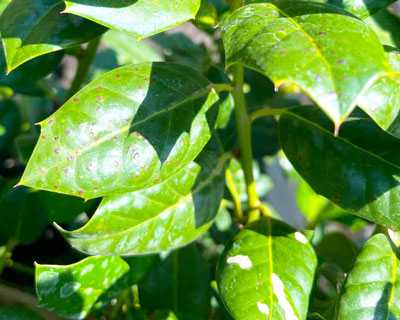
Answer: I’m seeing early stages of leaf miner damage, similar to what another reader asked about here recently See Question 15 last week from Brent F. in McKinney. His plants are farther along with the problem. You’ll see my suggestions to him.
Question 2
DOES FLORATAM FOLLOW THE SAME CARE GUIDELINES AS ST. AUGUSTINE?
Question: We moved here less than a month ago. I’m told I have a Floratam lawn. Does it follow the same care guidelines as St. Augustine? Will it crowd out bermudagrass? Tom S., Corpus Christi.
Answer: Floratam was one of the first selections of St. Augustine that was introduced jointly by the University of Florida and Texas A&M (hence the name) due to its resistance to the fatal St. Augustine decline virus. It’s a slightly larger grass than common St. Augustine, but unfortunately, it’s also not reliably winter-hardy in the northern two-thirds of Texas. Thousands of us discovered that expensive fact the first winter it was available. But it will be fine for you in Corpus Christi. Yes, it will crowd out berdmuagrass if you give it normal St. Augustine care and attention.
Question 3
HELP WITH HOUTTUYNIA!
Question: I have Houttuynia growing in my low boxwood plants. It is taking over everything. How can I get rid of it? Will I have to take the boxwoods up to re-do the soil? Cathy R., Edmond, Oklahoma.
Answer: Isn’t it a beast! I grew it once and thought I’d never get rid of it. For anyone unfamiliar with it, here is the description from the Missouri Botanical Garden.
If I were in your situation, I would rake back the mulch and roll out an overlapping covering of weed-blocking landscape fabric. Fit it up around the trunks of the boxwoods. Allow 4-5 inches of overlap to prevent the runners from coming up between pieces. You can put the bark mulch back on top of the fabric to make it all look better. Leave it in place for a year or two and you should be able to eliminate the unwanted invader.
QUESTION 4
IS THIS TREE WORTH SAVING?
Question: After the February 2021 freeze this tree struggled over the summer. This spring it appears to continue to struggle, sparse leaves, and peeling bark at base. Is this tree worth saving or should I replace it? Sallie S., Cross Roads, Denton Co.
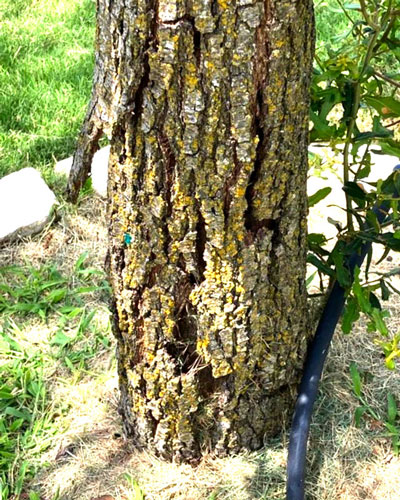
Answer: I’ve had this question several times recently, but because so many people are asking I’ve left it in. This is radial shake and it’s the result of the extreme cold the tree endured in February 2021. Not all live oaks were hurt badly. In fact, some were not hurt at all. However, looking at your other photograph, your tree is not going to make it. It has fewer than 10 percent of what would be its normal leaf count. You need to cut it or have it cut for you before it falls. I’m sorry for that bad news. We probably lost 10 percent of our live oaks in the North Central Texas area during that cold spell.
QUESTION 5
WHAT’S WRONG WITH THIS LAWN?
Question: What would cause the grass to die like this? The grass and soil have been replaced several times and each time the problem comes back just like this, just a little larger. Cheryl B., Garland.
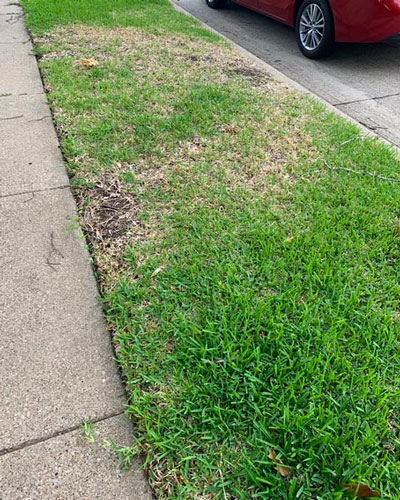
Answer: I can’t tell from this distance. If it shows up primarily in early spring and then gets worse as April and May roll on, then it probably is take all root rot. That fungal disease has become a serious problem in the spring and in alkaline soils. If it waits until it turns hot to attack the grass it probably is gray leaf spot. If it shows up all season long then it could be something as simple as pedestrian traffic. It may be that people are getting out of their cars in the same location time after time. It would be odd for a disease to recur where there is new grass and new soil. Diseases are identified by looking at specimens close-up. That’s the best I can do from this one photo. I have more St. Augustine diagnostics on my website.
QUESTION 6
IS THIS NUTSEDGE?
Question: I hear about nutsedge, but I don’t even know what it looks like. I bought Sedgehammer, but now I’m wondering if it’s safe to use around my new Nellie R. Stevens hollies. Eddie B., Fort Worth.
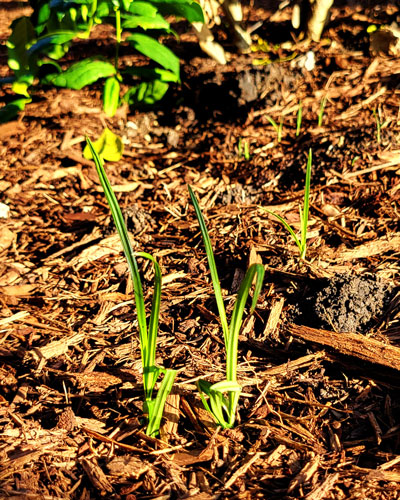
Answer: Indeed, this is nutsedge. You can always identify true sedges by rolling their stems between your index finger and your thumb. Sedges have triangular stems. Grasses have circular stems. Sedgehammer has a more limited label than Image, the other nutsedge control product. Before you use it around shrubs check the label carefully. It might be that Image would be a better choice. I’m talking about the original Image that was specifically intended for control of nutsedge in turf and landscape beds.
QUESTION 7
WHAT’S WRONG WITH THE VERBENAS?
Question: That’s wrong with these verbenas? They grew well for a while, then stopped blooming. They look terrible. Pam M., Waxahachie.
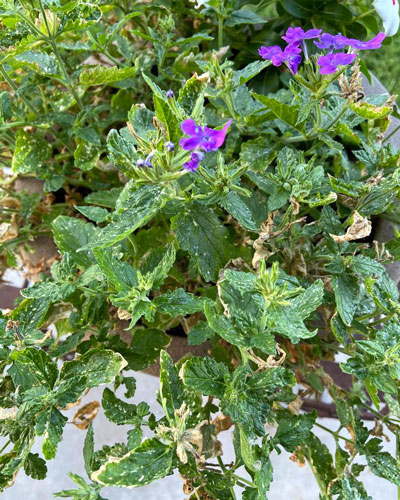
Answer: Verbenas are known to be susceptible to spider mites, but this didn’t match their symptoms very well at all. I decided I’d ask my friend Greg Grant who has done a ton of research on bringing new verbenas to Texas gardeners. He says, “I would suspect thrips. And possibly virused stock. Herbicide damage not out of the realm either.” Those are all challenging problems. I would suggest taking generous samples to a Texas Master Certified Nursery Professional for a close inspection and accurate diagnosis.
QUESTION 8
HOT TO STOP POWDERY MILDEW, SQUASH BUGS
Question: My yellow squash and zucchini were growing nicely. Huge foliage and fruit. Then bam! Powdery mildew and squash bugs took over. I’m using Neem oil to treat. What can I do in the future to prevent this all from happening? Kathi R., Wylie.
Answer: There are fungicidal sprays that will help with powdery mildew. I’ll let you work with your local nursery professional to find one that gives you good results. For squash bugs, Texas A&M vegetable specialists recommend dusting the ground and the crowns of the plants as well as the bottoms of the leaves and stems with Sevin insecticide starting before you have any known problem. By the time you have mature, adult squash bugs you will have waited too long. You can also destroy the egg masses on the undersides of the leaves.
QUESTION 9
HOW TO ELIMINATE GRASSBURS
Question: How can I get rid of 10 acres of grassburs? Normal weed herbicides won’t touch them. Johnny V., Leon County.
Answer: Your local farm supply store will have pre-emergent herbicide products that will work on them. The only problem is that they must be applied before the weed seeds sprout. That means a week or two before the average date of the last killing freeze for Leon County. That would put you in early March. You would need a follow-up “booster” application in early June. But without the first application the second one would be worthless. Talk to your farm supply specialist for product information for next year. They may have some kind of post-emergent weedkiller that you could use now.
QUESTION 10
HOW TO ELIMINATE THE FORMAL LOOK
Question: What is the best way to change from this highly sheared formal look to a more natural look as you have recommended? Or do we need to remove everything and start with new plants? Could we wait until winter and cut things back dramatically?

Answer: If you were to remove the highly sheared plants it would give you a chance to work with a landscape designer to plan new bed configurations. That way you wouldn’t have the bed edging and step all intersecting at the same place. Starting with new plants would also be neat and tidy from the start. You could certainly try drastic cut-backs in mid- to late winter so that all of next year’s new growth would be put to good use. You could even use lopping shears now to reach into each plant and pick-prune out some of the biggest, stubbliest (how’s that for a word!) branches to begin to open things up. Follow that up with an application of an all-nitrogen fertilizer to get a burst of new growth. Use plants that will stay smaller as they mature. You might want to save the low shrubs in front of your porch. The small tree looks great now, but it’s going to run into your house as it grows larger. I can’t tell if it’s a Japanese maple or a crape myrtle, but either way it’s blocking the window
QUESTION 11
CAN I REMOVE A DEAD OAK NOW?
Question: I’m in an oak-wilt area. Can I remove a live oak that is dead or almost dead? I know that regular pruning should be saved until winter. Lynn M., Brown Co.

Answer: You can remove this tree now. Don’t use your pruning tools to trim any other oaks without cleaning it, and don’t leave the wood lying around afterwards. You’ll be fine.
QUESTION 12
WHY NO BUTTERFLIES?
Question: I planted a butterfly, bee and hummingbird garden this spring as I always do. So far, no butterflies or bees. Why?
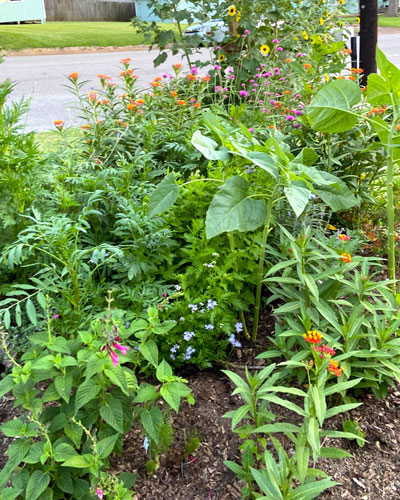
Answer: Be patient. It looks to me like many of the flowers are just getting started. I would suggest that you fertilize them and water them deeply and wait a few weeks. Good luck!
QUESTION 13
HOW LONG UNTIL MULCHED LEAVES BECOME SOIL AMENDMENTS?
Question: Each December I mulch all of my leaves and place them on my flower and shrub beds. I do not rototill them into the soil. They form a layer of mulch 2 to 3 inches deep. When will those leaves begin to amend my soil and improve its quality? Mike C., Grapevine.
Answer: if you don’t rototill them into the soil it’s going to take many years. If you’re dealing with shrubs, that doesn’t really matter, but with flowerbeds you do have time between plantings of annuals to run a mini-tiller through the soil and work the shredded leaves into the top couple of inches. However, it would be better if you could compost them a year or so before you used them. Fresh organic matter has a bad habit of tying up nitrogen in the soil. You want it to be partway through the decaying process.
QUESTION 14
WHY ARE THERE SMALL DEAD PATCHES IN MY ST. AUGUSTINE?
Question: Why does my St. Augustine on one side of my front yard have small dead patches. Could this be brown patch?
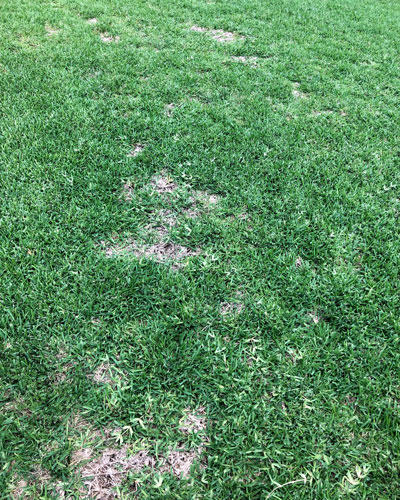
Answer: This doesn’t look at all like brown patch. Unfortunately for me, it also doesn’t look at all like take all root rot, gray leaf spot, chinch bugs or white grub worms – the other common St. Augustine maladies. What it does look exactly like is urine damage done by a female dog. (Males typically mark tree trunks, while females are more “free range” in their habits.) Why it would be only on one side of the yard is another question. One for which I have no suggestion. For what it’s worth, we have Zeus the dog. Although he’s quite masculine, his bathroom habits are rather girlie. My mondograss beds have spots just like this. We’re having talks. (If I’ve missed the boat with my answer, apologies. I’ve seen this so many times in backyards where dogs are confined.)
QUESTION 15
CAN PRE-EMERGENT BE APPLIED TO A NEWLY SEEDED LAWN?
Question: Can I apply the second dose of my pre-emergent if I seeded 2-3 weeks ago and have new grass coming up? Ellen G., Oak Point, Denton Co.
No. Remember that most pre-emergents are effective for 100 days. I’m surprised you’re getting good germination. And remember that the instructions always tell us we should not apply pre-emergent granules until a lawn has been through its first winter. So not only can you not apply it now, but you also won’t be able to make the late August/early September application to prevent the winter weeds.
QUESTION 16
GETTING ST. AUGUSTINE OUT OF BERMUDA
Question: I have St. Augustine coming up in my bermudagrass. Is there any way to get rid of it? Kristi C., Decatur.
Answer: We used to use MSMA for that exact purpose. It killed St. Augustine as well as dallisgrass and other weed grasses in bermuda turf without harming the bermuda. But it’s no longer on the consumer market. Unfortunately, unless you find a company that still somehow has access to MSMA you’re going to have to be extremely diligent in spot-treating just the St. Augustine with a glyphosate-only herbicide. It won’t contaminate the soil, but it will kill any St. Augustine on which it’s sprayed. Or you can dig it out by hand. You really need to establish some type of boundary edging to keep it from invading in the first place. It has to come in from the sides. St. Augustine does not produce viable seeds that could sprout.
QUESTION 17
HOW CAN VITEX BE RESHAPED?
Question: I have three vitex plants that I had trained as trees. They were beautiful until the cold of February 2021. Can I cut them down to the ground and start over? Michelle S., Fort Worth.
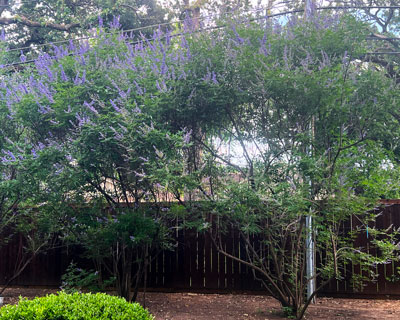
Answer: I wouldn’t trim them that dramatically. While crape myrtles will come back from that kind of pruning, vitex would be hurt by it. I would trim that back by 40-50 percent, tailoring them as you do. Do it in late January so you can take advantage of all the new growth next spring. All of that said, these do appear to be very close together. And, maybe it’s just the lighting, but they also appear to be getting a great deal of shade. That’s not good for normal regrowth and flowering.
QUESTION 18
HOW AND WHEN TO PRUNE BLACKBERRIES
Question: How and when do I trim my blackberry plants? Lonnie S., Allen.
Answer: Blackberry canes bear their fruit on stems that grew the prior year. They will never bear fruit again. Using current dates, canes that have had berries in spring 2022 grew in 2021. Once all the fruit has been harvested from those canes (about now), they should be cut back to the ground. Lopping shears are the tool of choice. Meanwhile, there should be strong new 2022 canes shooting up right alongside. Those canes will produce fruit next year (2023). Leave them in place, but pinch the growing tips out to keep them no taller than 40 to 44 inches. That will also encourage side branches to develop, creating more fruit-bearing surfaces in the process.
QUESTION 19
HOW SERIOUS IS RUST ON REDBUDS?
Question: Will rust on Texas redbuds cause leaves to drop? How serious is it? How can I treat for it? Daniel C., New Braunfels.
Answer: If the leaves are infected with rust it can definitely cause them to drop. Prematurely lost foliage is never a good thing. There are several good fungicides available at full-service nurseries. They will stop further development of the fungus, but next year you’ll want to spray considerably earlier in the season. For what it’s worth, this isn’t a common problem with redbuds. A photo would have been a big help to confirm that this is a rust.
QUESTION 20
WHAT TEXAS NATIVE FOR GROUNDCOVER?
Question: Referring back to your root flare situation, what Texas natives would you recommend rather than liriope and purple wintercreeper? Pam W., Bryan.
Answer: I grew up in College Station with a family of TAMU botanists around me. I’m pretty familiar with the native plant options from Brazos County. Reminder: a plant is native where you find it growing naturally. As soon as you try to grow it even 25 or 50 miles from its true native home, it may not thrive. (Loblolly pines of Huntsville versus Brazos County are a great example.) So, the low-growing plants that come to mind for you would be coralberry and dwarf yaupon holly. They’re both suited to shade, but honestly, neither would be my choices because they’re a bit taller than I would like. I’d probably prefer to have a nice bed of mulch or small, decorative rock. I’m not a “native plant purist.” I am much more an advocate of using plants that are well adapted to an area of Texas, and that’s why I suggested the two that I did. Totally a personal opinion.
QUESTION 21
TOMATOES JUST AREN’T RIPENING
Question: I planted Early Girl tomatoes in late March. The plants are huge and full of clusters of green tomatoes, but the fruit aren’t even starting to blush to pink or red. Am I getting nervous too soon? Debbie R., Denton.
Answer: It’s understandable. I get this question frequently, and just to double check my thinking, I did a quick search online to see what university sites suggest might cause it. Frankly, you’ll see all kinds of explanations. Two that really seemed plausible this year were high temperatures and strong winds (that would blow away any ethylene gas that would be forming around the ripening fruit). We certainly have had both of those. I also interject the off chance that the variety might have been mislabeled, either by the wholesale transplant grower or by the retail nursery. You might try picking some of the fruit and laying it on newspaper on a bright counter in your home. Tomatoes ripen normally with no loss of flavor or nutritional value. That might be a good compromise. I always do that with my fall tomatoes the night of the first killing freeze.
QUESTION 22
A LIQUID FERTILIZER FOR ST. AUGUSTINE
Question: Is there a liquid fertilizer for St. Augustine lawns? Phyllis J., Cedar Hill.
Answer: I’m sure you could find some, but you really don’t want to. A liquid fertilizer, by its nature, has to be water-soluble. That means that it I can be utilized immediately by the turfgrass, but it also means that it has no “staying power” to remain in the soil. After you water your lawn a few times all of the nutrition will be gone. Unless there are some special and unusual circumstances, you want to use an all-nitrogen granular fertilizer with 30 to 40 percent of that nitrogen in slow-release form.
QUESTION 23
HOW TO ELIMINATE DAYFLOWER
Question: Several years ago I brought in mulch that was contaminated with dayflower seeds. Now the beds are full of the plants. They have deep roots, and they re-seed prolifically. It breaks if I try to pull it. How can I get rid of it? John P., Arlington.
Answer: Dayflowers are, just as you described them, really difficult to eliminate. I’ve had the best results using roll-type mulch for a year or two to choke them out. That, plus a different brand of compost or bark mulch that you know to be free of their seeds. Broadleafed weedkiller sprays will kill them, but they’re challenging. Their leaves are thick and waxy enough to repel the herbicides, plus the stems are wiry. It’s tough to spray accurately without drift getting onto your desirable plants. I prefer not to try that route. I keep them chopped off as soon as I see them starting to grow, then I use the roll mulch to try to get rid of them.
QUESTION 24
FIXED DRAINAGE PROBLEM – NOW HOW TO FIX THIS WEED?
Question: We had drainage problems corrected six months ago (December 2021). They tore out all the bermuda and lowered the grade, then new sod was put down. Now I have tons of (I think) crabgrass. Is it safe to use crabgrass killer and then pre-emergent this coming fall on the new sod?
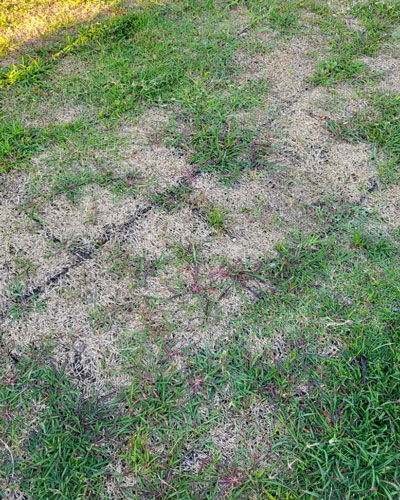
Answer: I would be talking to the people who planted your new sod. There is a chance that it had dried out and died before it was planted. That’s the problem with planting dormant sod in mid-winter. You can’t tell if it’s dormant or dead. Of course, there’s also the chance that you didn’t water it properly over the winter. Either way, I’m not seeing much actual bermuda alive and well in the newly resodded area. As for the weed, I don’t believe that’s crabgrass. You’ll want to use a tank sprayer with a nozzle set precisely so you can follow the runners of the grass as you spray a glyphosate-only herbicide right down the runners. Glyphosates don’t contaminate the soil, yet they do a great job of killing unwanted grasses. The real question, however, still is whether you have enough bermuda in that area to fill in within this growing season. Finally, as I’ve mentioned to another reader in another question here, no, you do not want to apply a pre-emergent this fall – not until new grass has been through its first entire winter.
